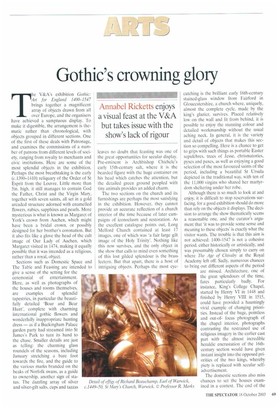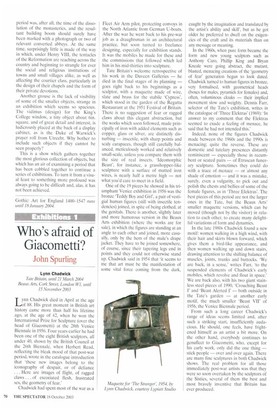Gothic's crowning glory
Annabel Ricketts enjoys a visual feast at the V&A but takes issue with the show's lack of rigour
The V&A's exhibition Gothic: Art for England 1400-1547 brings together a magnificent array of objects drawn from all over Europe, and the organisers have achieved a sumptuous display. To make it digestible, the arrangement is thematic rather than chronological, with objects grouped in different sections. One of the first of these deals with Patronage, and examines the commissions of a number of patrons from different levels of society, ranging from royalty to merchants and civic institutions. Here are some of the most splendid objects in the exhibition. Perhaps the most breathtaking is the early (c.1390-1410) reliquary of the Order of St Esprit from the Louvre. Little more than 5in. high, it still manages to contain God the Father, Christ and the Virgin Mary, together with seven saints, all set in a gold arcaded structure adorned with enamelled flowers, rubies, sapphires and pearls. More mysterious is what is known as Margaret of York's crown from Aachen, which might have been a bridal crown, or possibly designed for her brother's coronation. But it also fits like a glove the head of the cult image of Our Lady of Aachen. which Margaret visited in 1474, making it equally possible that it was intended as a religious, rather than a royal, object.
Sections such as Domestic Space and The Table and Feasting are intended to give a sense of the setting for the ceremonial of entertainment. Here, as well as photographs of the houses and rooms themselves, are examples of splendid tapestries, in particular the beautifully detailed 'Boar and Bear Hunt', complete with charming international gothic flowers and wonderfully inappropriate hunting dress — as if a Buckingham Palace garden party had streamed into St James's Park to turn its hand to the chase. Smaller details are just as telling: the charming glass roundels of the seasons, including January stretching a bare foot towards the fire, and the guide to the various marks branded on the beaks of Norfolk swans, as a guide to ownership, another sign of status. The dazzling array of silver and silver-gilt salts, cups and tazzas leaves no doubt that feasting was one of the great opportunities for secular display. Pre-eminent is Archbishop Chichele's early 15th-century salt, where it is the bearded figure with the huge container on his head which catches the attention, but the detailed green ground peopled with tiny animals provides an added charm.
The two sections on the church and its furnishings are perhaps the most satisfying in the exhibition. However, they cannot provide an accurate reflection of a church interior of the time because of later campaigns of iconoclasm and restoration. As the excellent catalogue points out, Long Melford Church contained at least 17 images, one of which was 'a fair large gilt image of the Holy Trinity'. Nothing like this now survives, and the only object in the show that calls to mind even something of this lost gilded splendour is the brass lectern. But that apart, there is a host of intriguing objects. Perhaps the most eye
catching is the brilliant early 16th-century stained-glass window from Fairford in Gloucestershire, a church where, uniquely, almost the complete cycle, made by the king's glazier, survives. Placed relatively low on the wall and lit from behind, it is possible to enjoy the stunning colour and detailed workmanship without the usual aching neck. In general, it is the variety and detail of objects that makes this section so compelling. Here is a chance to get to grips with such things as portable Easter sepulchres, trees of Jesse, chrismatories, pyxes and paxes, as well as enjoying a good selection of the most favoured saints of the period, including a beautiful St Ursula depicted in the traditional way, with ten of the 11.000 virgins who shared her martyrdom sheltering under her robe.
Although there is so much to look at and enjoy, it is difficult to stop reservations surfacing, for a good exhibition should do more than rely on the objects it displays. The decision to arrange the show thematically seems a reasonable one, and the curator's argument that 'it was to provide some sense and meaning to these objects' is exactly what the visitor wants. The trouble is that this aim is not achieved: 1400-1547 is not a cohesive period, either historically or artistically, and was presumably chosen simply to carry on where The Age of Chivalty at the Royal Academy left off. Sadly, numerous chances to bring out different aspects of the period are missed. Architecture, one of the great splendours of the time, fares particularly badly. For instance, King's College Chapel, started by Henry VI in 1448 and finished by Henry VIII in 1515, could have provided a hauntingly vivid example of changing priorities. Instead of the huge, pointless and out-offocus photograph of the chapel interior, photographs contrasting the restrained use of religious imagery in the earlier east part with the almost incredible heraldic encrustation of the 16thcentury section would have given instant insight into the opposed priorities of the two kings, whereby piety is replaced with secular selfadvertisement.
The domestic sections also miss chances to set the houses examined in a context. The end of the period was, after all, the time of the dissolution of the monasteries, and the resultant building boom should surely have been marked with a photograph or two of relevant converted abbeys. At the same time, surprisingly little is made of the way in which. under Henry VIII, the tentacles of the Reformation are reaching across the country and beginning to strangle for ever the social and religious institutions of towns and small villages alike, as well as affecting the courtier class, particularly in the design of their chapels and the form of their private devotions.
Another grouse is the lack of visibility of some of the smaller objects, strange in an exhibition which seems so spacious. The vidimus (design) for the King's College window, a tiny object about 6in. square, and of great detail and interest, is ludicrously placed at the back of a display cabinet, as is the Duke of Warwick's prayer roll from Utrecht. Why bother to include such objects if they cannot be seen properly?
This is a show which gathers together the most glorious collection of objects, but which has an air of examining a period that has been cobbled together to continue a series of exhibitions. To turn it from a visual feast to something more profound was always going to be difficult and, alas, it has not been achieved.
Gothic: Art for England 1400-1547 runs until 18 Janua?), 2004.



































































































 Previous page
Previous page